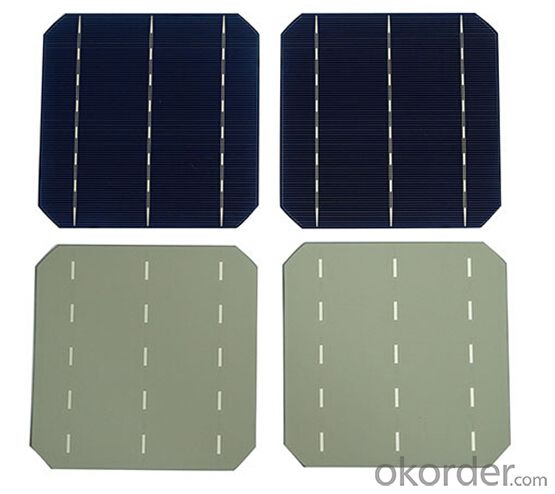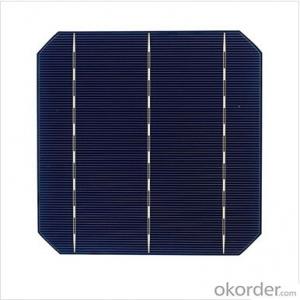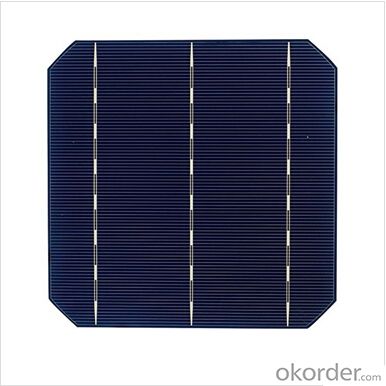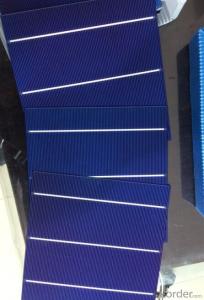Monocrystalline Solar Cells A Grade 17.4%
- Loading Port:
- Shanghai
- Payment Terms:
- TT OR LC
- Min Order Qty:
- 5000 pc
- Supply Capability:
- 800000 pc/month
OKorder Service Pledge
OKorder Financial Service
You Might Also Like
Monocrystalline Solar Cells A GRADE
A solar cell, is an electrical device that converts the energy of light directly into electricity by the photovoltaic effect, which is a physical and chemical phenomenon. It is a form of photoelectric cell, defined as a device whose electrical characteristics, such as current, voltage, or resistance, vary when exposed to light. Solar cells are the building blocks of photovoltaic modules, otherwise known as solar panels.
Advantage of Monocrystalline Solar Cells
• High efficiency and stable performance in photovoltaic conversion.
• Advanced diffusion technique ensuring the homogeneity of energy conversion efficiency of the cell.
• Advanced PECVD film forming, providing a dark blue silicon nitride anti-reflection film of homogenous color and attractive appearance.
• High quality metal paste for back surface and electrode, ensuring good conductivity, high pulling strength and ease of soldering.
• High precision patterning using screen printing, ensuring accurate busbar location for ease with automatic soldering a laser cutting.
Specifications of Monocrystalline Solar Cells
Efficiency (%) Pmpp (W) Umpp (V) Impp (A) Uoc (V) Isc (A) |
18.20% 4.43 0.536 8.263 0.634 8.712 |
18.00% 4.38 0.535 - 8.188 0.633 8.701 |
17.80% - 4.33 0.534 - -8.112 ---0.632 ----8.652 |
17.60% 4.28 0.533 8.036 0.631 8.641 |
17.40% 4.23 0.529 8.005 0.630 8.591 |
Applications of Monocrystalline Solar Cells
Assemblies of photovoltaic cells are used to make solar modules which generate electrical power from sunlight, as distinguished from a "solar module" or "solar panel". A solar array generates solar power using solar energy.
Packaging & Delivery of Monocrystalline Solar Cells
Carton Box Package and Deliver by air. It should be noticed that it should be avoid of water, sunshine and moist.

FAQ
We have organized several common questions for our clients,may help you sincerely:
①What price for each watt?
It depends on the efficiency of the solar cell, quantity, delivery date and payment terms.
②How long can we receive the product after purchase?
In the purchase of product within three working days, We will arrange the factory delivery as soon as possible. The pecific time of receiving is related to the state and position of customers.Commonly 7 to 10 working days can be served.
③Can you provide the peripheral products of the solar panels, such as the battery, controller, and inverter? If so, can you tell me how do they match each other?
Yes, we can, we have two companies for solar region, one is CNBM International, the other is CNBM engineering Co.
We can provide you not only the solar module but also the off grid solar system, we can also provide you service with on grid plant.
④What is your warranty of solar cell?
Our product can promise lower than 0.3% open box crack, we support claim after opening the box if it has crackm color difference or sth, the buyer should give pictures immediately, we can not accept the claim after the solar cell has assembled to solar panel.
• Timeliness of delivery
• ⑤How do you pack your products?
We have rich experience on how to pack the solar cell to make sure the safety on shipment, we could use wooden box or pallet as buyer's preference.
⑥ Can you do OEM for us?
Yes, we can.
- Q:Can solar cells generate power at night?
- No, solar cells cannot generate power at night as they rely on sunlight to produce electricity.
- Q:What is the future of solar cell technology?
- The future of solar cell technology holds great potential for advancements in efficiency, affordability, and integration into various applications. Researchers are constantly exploring new materials, such as perovskites and organic polymers, to overcome the limitations of traditional silicon-based solar cells. Innovations like tandem solar cells and multi-junction solar cells are expected to significantly increase conversion efficiency. Additionally, advancements in manufacturing techniques, such as printing and roll-to-roll processes, aim to reduce production costs and facilitate large-scale deployment. Integration of solar cells into everyday objects, like windows, clothing, and electronic devices, is also an exciting prospect. Overall, the future of solar cell technology seems promising and will play a crucial role in transitioning towards a more sustainable and renewable energy future.
- Q:Can solar cells be used in remote monitoring systems?
- Yes, solar cells can be used in remote monitoring systems. Solar cells are an ideal power source for remote monitoring systems as they convert sunlight into electricity, providing a sustainable and reliable source of power even in remote or off-grid locations. This eliminates the need for traditional power sources or frequent battery replacements, making solar cells a cost-effective and environmentally friendly solution for powering remote monitoring systems.
- Q:Can solar cells be used to power satellites?
- Yes, solar cells can be used to power satellites. In fact, solar cells are the primary source of power for most satellites orbiting the Earth. They convert sunlight directly into electricity, providing a reliable and renewable energy source for the electrical systems on board the satellite.
- Q:Can solar cells be used for powering universities?
- Yes, solar cells can definitely be used for powering universities. Solar energy is a reliable and sustainable source of power that can be harnessed through solar cells or panels. By installing solar panels on university buildings or campuses, universities can generate clean electricity, reduce their carbon footprint, and potentially save on energy costs in the long run.
- Q:What is the environmental impact of solar cells?
- The environmental impact of solar cells is generally positive. They produce clean and renewable energy, reducing greenhouse gas emissions and dependence on fossil fuels. However, their production does require some raw materials and energy, which can have environmental consequences. Additionally, the disposal of older solar panels may pose challenges in terms of electronic waste management. Overall, though, the benefits of solar cells outweigh their environmental drawbacks.
- Q:Can solar cells be used in desert areas?
- Yes, solar cells can be used in desert areas. In fact, desert areas are considered ideal locations for solar power generation due to their high solar radiation levels and vast open spaces. The availability of ample sunlight ensures efficient energy production by solar panels, making them a viable and sustainable option for generating electricity in desert regions.
- Q:What are the applications of solar cells?
- oil, marine, meteorological fields: oil pipelines and reservoir gates cathodic protection solar power systems, oil drilling platform life and emergency power, marine testing equipment, weather / hydrological observation equipment. (
- Q:What are the advantages of using solar cells?
- There are several advantages to using solar cells. Firstly, solar cells are a clean and renewable source of energy, which means they do not produce harmful emissions or contribute to climate change. Secondly, solar cells can be installed in remote areas without access to electricity grids, providing power to communities that would otherwise be without it. Additionally, solar cells require minimal maintenance and have a long lifespan, making them a cost-effective solution in the long run. Finally, using solar cells reduces dependence on fossil fuels, helping to conserve natural resources and promote a more sustainable future.
- Q:Can solar cells be used to power surveillance cameras?
- Yes, solar cells can be used to power surveillance cameras. Solar power can provide a reliable and sustainable source of energy for surveillance cameras, eliminating the need for traditional electrical wiring or frequent battery changes. Solar panels can capture sunlight and convert it into electricity, which can then be stored in batteries to power the cameras day and night. This makes solar-powered surveillance cameras an eco-friendly and cost-effective solution, particularly in remote or off-grid locations.
1. Manufacturer Overview |
|
|---|---|
| Location | |
| Year Established | |
| Annual Output Value | |
| Main Markets | |
| Company Certifications | |
2. Manufacturer Certificates |
|
|---|---|
| a) Certification Name | |
| Range | |
| Reference | |
| Validity Period | |
3. Manufacturer Capability |
|
|---|---|
| a)Trade Capacity | |
| Nearest Port | |
| Export Percentage | |
| No.of Employees in Trade Department | |
| Language Spoken: | |
| b)Factory Information | |
| Factory Size: | |
| No. of Production Lines | |
| Contract Manufacturing | |
| Product Price Range | |
Send your message to us
Monocrystalline Solar Cells A Grade 17.4%
- Loading Port:
- Shanghai
- Payment Terms:
- TT OR LC
- Min Order Qty:
- 5000 pc
- Supply Capability:
- 800000 pc/month
OKorder Service Pledge
OKorder Financial Service
Similar products
New products
Hot products
Hot Searches
Related keywords


































